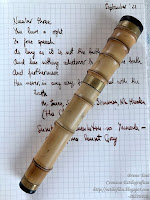We saw on past texts that Ôhashidô traces its history back to 1912, but the production of pens only started in the late 1950s by the hand of Eiichi Uehara, who founded Ôhashidô Ltd. in 1965. He was in charge of the company until 2010, when he passed it onto his son Yûichi, the current craftsman behind the operation.
Therefore, there are Ôhashidô pens by the hand of Eiichi as there are by his son Yûichi. How do they compare?
The pen on this first picture was manufactured by Eiichi Uehara.
The most clear difference is the better polishing on the older pen by Eiichi. Then, the whole construction and fitting seems more refined as well.
It is labeled –twice-- on the rings: “J. S. U. ÔHASIDÔ SINCE 1912”. The nib, a 14 K unit by Sailor, carries the usual engraving we can still see nowadays. The Sailor logo is also included but hidden under the section. This particular unit is not dated.
These are the dimensions of this older pen:
Length closed: 138 mm
Length open: 125 mm
Length posted: 154 mm
Diameter: 13.3 mm
Weight: 22 g
Ink deposit: 0.7 ml (converter) – 1.2 ml (cartridge)
This older pen is also more generous in all that is not the pen. The “kiribako” --the paulownia wooden box-- is basically the same in both old and new pens, but the old unit came with a pen case and three documents: an instruction sheet, a booklet explaining the history of the brand, and a third sheet describing the pen itself.
And what we see on those documents is as interesting as the pen itself, but that will be the topic of the next Chronicle.
Ohashido Pro III – Lamy Dark Lilac
Bruno Taut
October 5th 2022
etiquetas: Ohashido
Bruno Taut
October 5th 2022
etiquetas: Ohashido




































